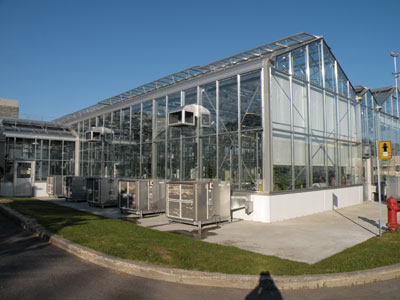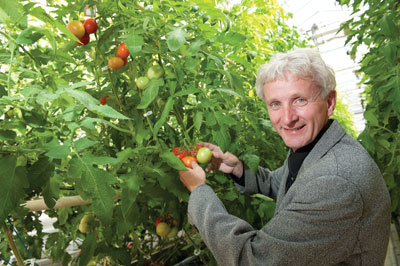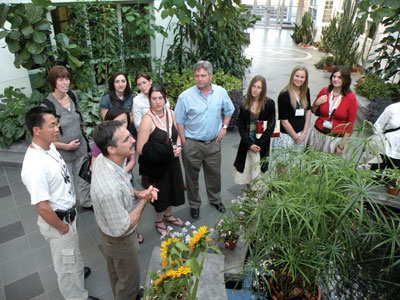
Higher yields and better quality, over a longer season, in order for local producers to take a bigger share of the local market – such has been Dr. André Gosselin’s lifelong mission, one that has considerably altered the face of horticulture in Québec.
Higher yields and better quality, over a longer season, in order for
local producers to take a bigger share of the local market – such has
been Dr. André Gosselin’s lifelong mission, one that has considerably
altered the face of horticulture in Québec.
Last November, the Université Laval (Québec City) researcher was
honoured with the Prix Lionel-Boulet 2009, the Québec government’s
highest distinction in industrial R&D. For the first time, the
award was given to a researcher in horticulture.
“I see this award as a recognition of the importance of our
horticulture sector by the government of Québec,” Dr. Gosselin told
Greenhouse Canada.
His early work involved testing and implementing new strawberry
varieties to his native Orléans Island. The growing season was
successfully extended from three weeks to up to five months. In 1979,
he founded Les Fraises de l’îles d’Orléans with family members. Still
today, Dr. Gosselin’s involvement in the company keeps it at the
forefront of berry growing technologies. It grows the world’s first
nutraceutical strawberry and raspberry varieties, producing fruits with
record levels of antioxidants.
 |
| Some of the new facilities at Laval University; |
 |
| Dr. André Gosselin, at home in a greenhouse. (Photo by Rémy Boily) |
 |
| Dr. Gosselin was one of two co-chairs of the international Symposium on High Technology for Greenhouse Systems (GreenSys) conference hosted in Québec City last spring. It attracted many of the world’s leading researchers. Among highlights was a tour of Laval University. |
BEGAN HIS LAVAL TEACHING CAREER IN 1984
Dr. Gosselin obtained a masters degree and a PhD in greenhouse
cultures at Université Laval. In 1977, he did a one-year internship at
the University of Guelph. He became a professor at Laval in 1984.
In the early 1980s, lighting in greenhouses was mostly only used for
flowers. “People were telling us that for vegetables, artificial
lighting wouldn’t be feasible, because of costs.”
With his colleagues and graduate students, along with partnerships with
Hydro-Québec and private growers, Dr. Gosselin succeeded in providing
year-round lighting in greenhouses, at reasonable costs. High-pressure
sodium lights were used. Low electricity prices were a big help, he
admits.
In the last 20 years, sodium lights have become about 30 per cent more
efficient, he notes. The heat they generate helps raise the temperature
inside the greenhouse. The technology is now used in several parts of
Canada, as well as in France, Belgium, Holland, Scandinavia and the
U.S. They allow year-round production in areas where winter sunlight is
insufficient.
A CO-FOUNDER OF LES SERRES DU ST-LAURENT
In 1989, Dr. Gosselin co-founded Les Serres du St-Laurent, which
became Québec’s most important tomato grower. The company markets its
produce under the Savoura brand. It now employs 350 workers and its six
greenhouse complexes cover 18 hectares.
“We were probably the first ones in the world to produce with
artificial lighting on such a large area,” says Marie Gosselin (no
relation to Dr. Gosselin), general manager of Les Serres du St-Laurent.
Marie Gosselin remembers André Gosselin from the time she was a student
at Université Laval. “He was always a forerunner, someone with a lot of
ideas,” she says. “I think that we wouldn’t have gone all this way if
it weren’t for him.”
“André is a very well organized person, who knows how to gather
competent people around him,” says Les Fraises de l’île d’Orléans
R&D director Louis Gauthier. “If you have a good idea, he’ll always
give you a chance at trying it out.”
THE ROOTS OF LAVAL’S CENTRE DE RECHERCHE EN HORTICULTURE
Despite his involvement in two prominent horticulture businesses, Dr.
Gosselin says he is first and foremost a university professor
interested in research. In 1989, he founded Université Laval’s Centre
de recherche en horticulture. “We have had more than 600 graduate
students. They are now employed everywhere in Québec’s horticulture
sector.”
Dr. Gosselin has held the positions of director of the phytology
department and dean of the faculty of agriculture and food sciences. He
was a key player in the $12-million construction project of the
Envirotron building, a university greenhouse research facility. He also
founded the Institut des nutraceutiques et des aliments fonctionnels, a
300-member research group on nutraceutics and functional foods.
In 2006, he founded Nutra Canada, a company that will market extracts
from berries and other functional foods. The concentrates will be
extracted in a newly constructed facility.
LATEST COMMERCIAL VENTURE FOCUSING ON FUNCTIONAL FOODS
“Our goal is to concentrate molecules that have health properties,”
Dr. Gosselin explains. “We only work with foods from northern regions,
like blueberries, cranberries and strawberries.” The extracts could be
added to juices, yogurts or energy bars, for example.
“I have always worked with the same objective, that of increasing
productivity. Over the last few years, however, I have added a
nutrition component to my research.”
Among his many achievements is also the development of a chlorine-based
nutrient solution recycling system. Heat or ultra-violet systems used
in Europe are very expensive, he says. “Our chlorine disinfection
system works superbly well.”
All this R&D is necessary if domestic producers are to stay in
business despite competition from California, Mexico or China. “We try
to develop technology that will allow our producers to have an
increased presence on the market, over a longer period in the season
and that will make Canada more self-sufficient for fruit and
vegetables.”
André Dumont is a freelance writer and photographer in Québec.
Print this page